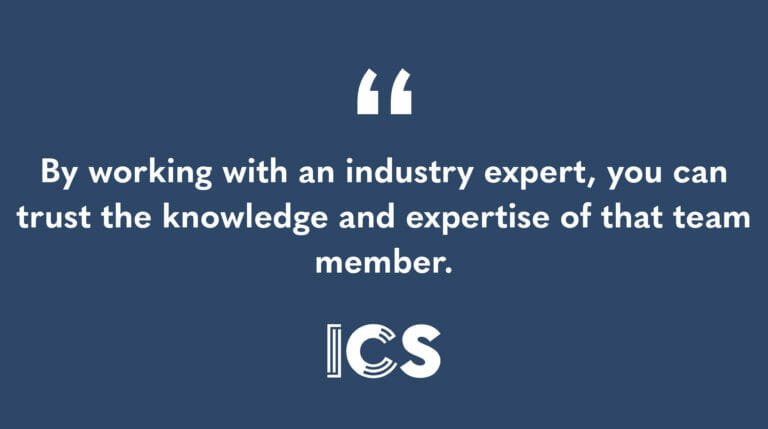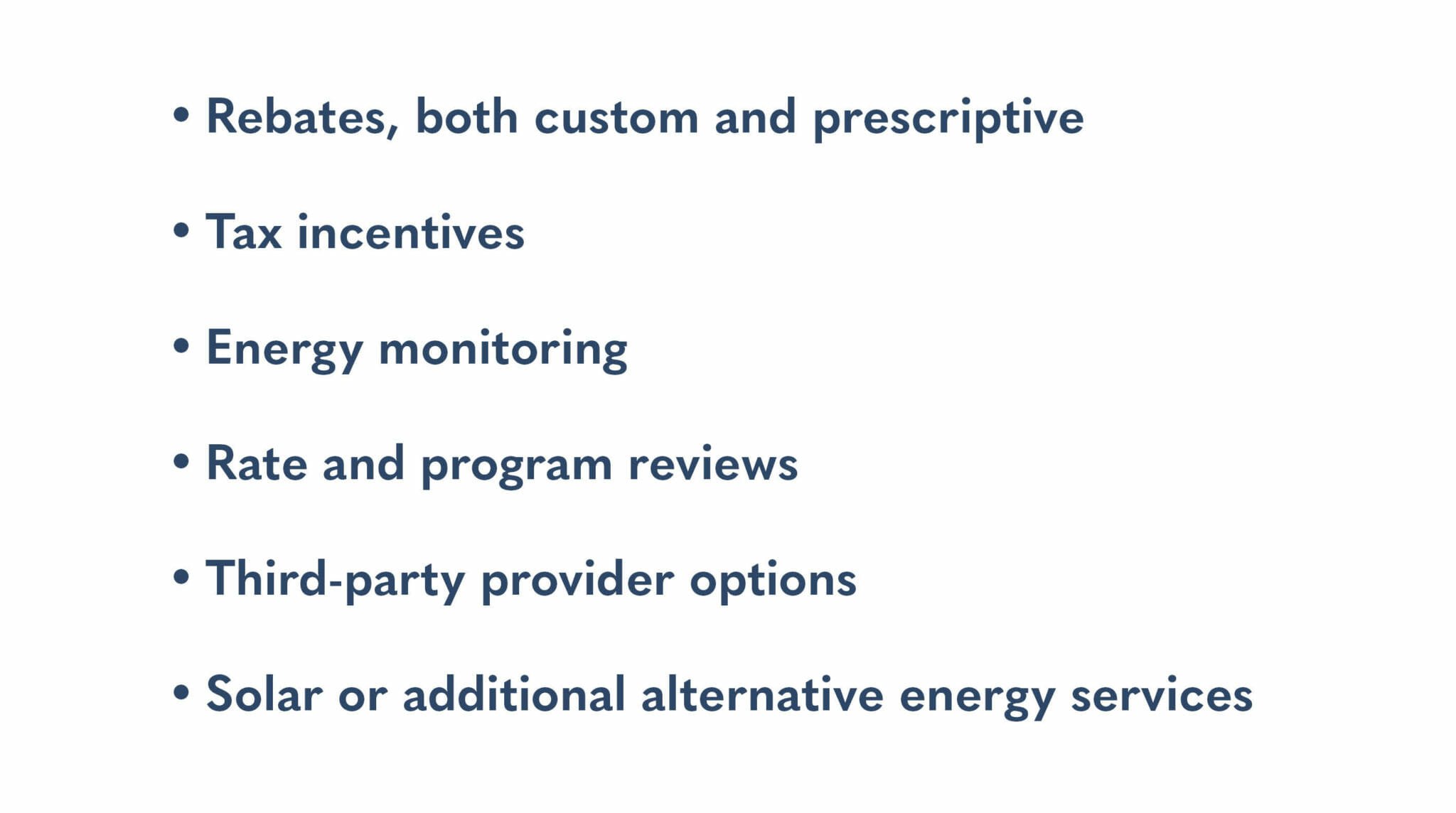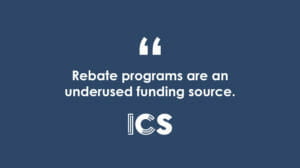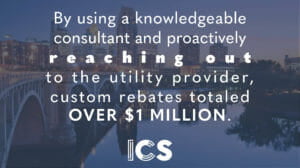When utilities and other infrastructure-support entities collaborate, everybody wins. Customers feel secure when their service providers can work together to create seamless projects. Coordination and cooperation show both professionalism and that the client’s needs are the top priority.
ENHANCED VISIBILITY FOR YOUR PROGRAMS AND OURS
Clients are inundated with information throughout the course of a project. By integrating your programs and services into an existing project, they are more likely to be adopted, used, and successful.
Project managers and owners’ representatives, such as ICS, have a direct line to your customer. When you connect with one of those companies and establish a business relationship, you then have a trusted advisor to your client in your court.
We meet regularly with leadership teams, and our program recommendations are trusted, considered, and implemented. Introducing new services to a customer can be tricky.
Mailings, emails, and other marketing materials may be overlooked when not directed to a specific person within a company. We can use our relationship to bring the appropriate items to the correct people.
This makes the job of the utility provider easier as well. When you work with a knowledgeable person, conversations flow easier, items and tasks are resolved more quickly, questions are direct, and answers are clear.
Customers may not understand what a program is, or how it may help them. By working with an industry expert, you can trust the knowledge and expertise of that team member.

Using professional relationships in this way means you reach a larger audience. Once you have established relationships with other industry experts, they will be more inclined to introduce your programs to their clients.
Rather than reaching customers one by one, you can target specific groups all at once for a broader reach.
Companies like ICS work with dozens of commercial buildings. Those owners rely on us to provide the best and most comprehensive services and programs. By ensuring that we are knowledgeable about your programs, you, as the client, can deliver projects that are feasible and thoughtful for increased stakeholder buy-in.
Often, clients are not aware that items such as rebate programs exist, and if they do, they’re unsure how to navigate them.
When the burden is taken off the client and placed into the hands of the service providers, the barrier to entry for additional programs is broken.

VALUE-ADDED SERVICES FOR OUR CLIENTS
Clients rely on us to guide them toward the options and to help them execute those options successfully. These value-added services come in many forms, such as the following:

Some of the most easily integrated and executed value-added services are energy monitoring, rebate programs, and tax incentives.
ENERGY MONITORING
Energy monitoring can be called many things—utility tracking, benchmarking, or measurement and verification, to name a few. In addition to various titles, there are just as many ways to implement it.
Introducing your client to a trusted provider of this service can help them to understand their energy use, save energy and money, and keep them interested in maintaining utility services.
According to Energy Star, simply tracking energy use and costs can result in a 2 percent overall decrease for commercial buildings. Reductions of 10 percent or more can be made when using that information to implement low- or no-cost conservation solutions.
These numbers are good for the client and good for their utility provider.
Monitoring energy use and using that information to inform building operations and project decisions have reduced overall energy use by ICS clients month after month.

For example, after assisting an elder care facility in Grand Rapids, Minnesota, on a capital improvement project, ICS stayed connected by providing ongoing energy monitoring services.
Through this continued relationship, we’ve gotten to know their utility provider representatives and have been able to regularly review rates, apply for rebates, and aid them in savings that have reached more than a 40 percent reduction in energy use and costs over the past three years.
REBATES
Rebate programs are an underused funding source. They can be complicated, time-consuming, technical and require many forms of documentation. The task most often falls to one of the engineers or contractors associated with a capital project.
However, even when completed, there are missed opportunities, as the rebates will likely be contained solely to that engineer’s expertise. ICS and other owner’s representation firms manage all the equipment and infrastructure associated with a building, ensuring that no category is missed.
We have relationships with everyone involved in a capital project and know the appropriate channels and parties for all necessary information. In addition to being able to navigate prescriptive programs, owner’s representatives can manage custom rebates as well.

A prominent real estate investor in downtown St. Paul, Minnesota, enlisted ICS to aid in the construction of three high-rise facilities that received significant energy upgrades for over 1.5 million square feet, including HVAC, controls, and new interior lighting.
By using a knowledgeable consultant and proactively reaching out to the utility provider, custom rebates totaled over $1 million. In addition, energy efficiency tax incentives generated over $2 million in immediate deductions, and PACE (Property-Assessed Clean Energy) financing provided interest-free dollars to ensure the project made money from day one.
Often, customers come to their utility provider because they have decided to do a large project and want to either review their rates or apply for rebates. One thing they may not realize is just how many tax incentive programs are available for the same equipment that utilities are already providing rebates for.
Rather than choosing one or the other, why not do both?
Major League Baseball in Minneapolis, Minnesota, has seen its share of changes in its short history since opening a new stadium. A utility-sponsored recommissioning program identified over $300,000 in annual energy savings, as well as uncovered the opportunity for the owner to claim an additional $1.2 million in additional tax deductions.
By working together, the utility and ICS created a significant benefit for the owner of more than 10 times the cost of doing the work.
EDUCATIONAL OPPORTUNITIES FOR EVERYONE
Better understanding the processes your clients go through means knowing when, and how, to best leverage your services.
Some programs require early intervention, while others have certain design stipulations that must be fulfilled. An advantage in this area is possessing a working knowledge of the pipeline that an owner’s representative, engineering, energy services, or financing firm works from.
Without this knowledge, valuable opportunities may be missed. Leveraging your relationships allows a better understanding of company processes to determine when and how to provide your services well.
Begin by learning who your clients work with regarding any energy-related projects. Who is their preferred capital project consultant? Do they employ an owner’s representative to manage construction projects? Who are their consultants regarding referendums or budget planning?
Reach out to these people and begin to integrate your utility offerings and programs into the conversations already being had. If a client is currently in the midst of a major building upgrade, make sure they’re aware of the rebate programs you offer.
If there’s a budget crisis, offer solutions that revolve around rate schedules and use-control options. Figure out what pains you can ease, and ensure that the message reaches the client.
When you know how the process works at companies such as ICS, you can intervene earlier and more frequently. Instead of jumping in after a project is completed, why not be part of the conversation during funding, design, and construction?
The project management cycle at ICS consists of six main parts. Your services may be inserted at any time during the cycle that is appropriate.

- Identify the needs. The first step is to find out what problems a client would like to solve. Once you have established what their needs are, solutions can be customized.
- Assess opportunities. There will likely be several paths a client could take in order to meet their needs. Prepare a pros and cons list that can be shared with the client directly, or via specific conversations with the other professional organizations they are working with. For example, if a building qualifies for rebates and your utility offers several different rebate options, provide a breakdown of each option showing the differences and various outcomes.
- Make a plan. This is where you will work directly with the other client-services professionals to decide how to best serve the client. Delegate and divvy up responsibilities. Assign specific point persons and discuss what communication will look like.
- Does your program or solution require additional or specific funding? If so, provide options on how to pay for what you are offering.
- Implement. Now that the solutions have been chosen, a plan is in place and everything is paid for, it’s time for action. Communicate openly and often with your cohorts, honor deadlines and make it happen.
- Communicate. To operate and maintain, it is essential for utilities and other service providers to remain in contact not just with the client, but with one another. As new programs are introduced, old offerings expire, and deadlines loom, ensuring that you’re not the only one providing this message to your client is key to continuing to identify needs and starting the cycle all over again. Continuous communication is key throughout this phase.
A large Twin Cities metro-area school district enlisted ICS to help in the remodeling of six of its buildings. By involving the district’s utility provider early in the design process, we were able to use custom rebates versus solely prescriptive, securing more than three times the rebate option for the client. The utility provider advised us on which equipment would qualify and which would not. The contractors receiving benefits were also willing to bid lower, knowing they would be receiving rebates as well.
The district is on track to receive more than $125,000 in rebate dollars during 2017. That’s something to get excited about!
WHO YOU SHOULD LEVERAGE RELATIONSHIPS WITH
Owner’s representatives/construction management firms, such as ICS, are not the only companies that can benefit from working directly with utility providers. Identify who is working with clients in your service area and get in touch with them to leverage your services and existing relationships.
Architects and engineers, contractors, energy services companies, project financial consultants, real estate developers, and government financing authorities such as PACE are all valuable places to start.
A few ways you can begin to establish relationships include the following:
- Attend professional conferences related to your client base and begin networking. Whether you work with school districts, healthcare facilities, private commercial businesses, or residential housing, there is a professional community that serves the same people you do.
- Identify the specific service providers your clients work with. If it is a public entity, such a municipality or nonprofit, you may be able to find information posted on their websites or by searching for their required publicly listed contracts.
- You may also choose to ask directly who else a client works with. Many times, clients are happy to connect their service providers, especially if the clients understand the benefits of doing so.

Identify a single, real person. Too often we send emails or letters to general addresses such as “Customer Service” or “Finance Department.” Seeking out a singular person to forge a relationship with will get you further faster. Express your interest in working together, ask to be educated on their relationship with your shared client, and share your value with them.
In this age of technology, it is far too easy to depersonalize and automate our communications. Putting in the effort to create and maintain human relationships will result in success. When service providers work together, everybody wins, especially our clients.

